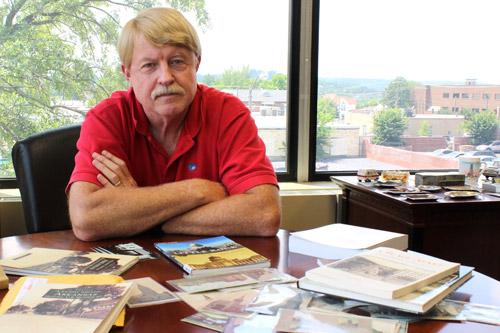
Poking around a flea market in 1975, Ray Hanley scooped up some antique postcards displaying scenes from Arkansas’ yesteryear. The lot set him back about a dime, he recalled.
Thirty-plus years later, the collection contains more than 25,000 images, making Hanley, a member of Our Lady of Good Counsel Church in Little Rock, an authority on antique postcards and the Arkansas history they capture.
“It’s interesting to see how far we’ve come in some areas,” Hanley said. “At the same time, people worried about a lot of the same things then as they do now — everyday life, who’s sick, who died.”
Given the nature of today’s postcards — garish tchotchke discarded almost as quickly as they reach the recipient — it’s hard to appreciate the significance of the medium’s ancestors. Long before cameras became an omnipresent accessory, few people could afford photographic equipment, which didn’t travel well anyway and were complicated to operate. Thus, professionally shot and mass-produced postcards became filler for photo albums and the era’s version of text messaging.
“The most sought-after postcards are the ones that captured events that only happened for a day or two,” said Hanley, who spends his day as the president and CEO of the Arkansas Foundation for Medical Care.
For example, the inaugural United Confederate Veteran’s Reunion was an event that ballooned Little Rock’s population from 45,000 to 150,000 in May 1911. An avalanche of postcards was produced to meet public demand, many of which are now prized specimens in the Hanley collection.
Other “spot news” events — storm aftermath, train derailments and natural disasters — were also highly coveted. Popular, too, were more sinister images. Ku Klux Klan rallies, racial, ethnic and religious bigotry and even lynchings found their way through the lens and onto the market as easily as landscapes or a prize-winning hog.
And, although pictures are in fact worth a thousand words, it’s the 20 or so on the reverse that sometimes speak the loudest. Hand-scrawled, the notes on the back — on Halley’s Comet, 1910 (“We’re still here,” reads the card), or a job picking Jonesboro berries, “for two cents a quart,” or even the decidedly blunt, “I’m landing me a big Arkansas man,” — all give poignant glimpses of daily life, love and struggle.
From the start, Hanley zeroed in on cards from the 1800s through about the 1960s, featuring scenes of all manner of things Arkansan, including houses of worship. The collection includes a number of cards featuring Catholic churches, most of them long gone wooden structures but some, like Little Rock’s St. Edward Church and the Cathedral of St. Andrew, appear almost exactly as they are today.
“With churches, some postcards pictured the outside while some showed the inside,” Hanley said.
As always, there’s a story behind the image. Pondering a postcard picturing an early St. John the Baptist Church in Brinkley, Hanley said, “In 1909, a tornado came through town and destroyed every church but the Catholic church. It quickly became the town morgue.”
In packaging images with these tantalizing historical bits, Hanley and his brother Steven have found a wide and enthusiastic audience. In 1986 the column, “Arkansas Postcard Past” debuted in the Arkansas Gazette and has been in print ever since. From there, it didn’t seem like a big leap to publishing books drawing from the collection; at least until Ray wrote a grant proposal to get the first project off the ground.
“I got back this snotty letter saying I was a career bureaucrat who didn’t have any credentials as a historian,” he recalled. “It made me mad and made me want to figure out how to do this on our own.”
To date, the brothers have published 16 books, each telling the story of a different corner of the Natural State, with a particular affection for scenes from Main Street. Several books focusing on individual communities or counties benefit local historical societies, such as the one done for the Hanleys’ hometown of Malvern.
As with all things collectible, most postcards today are in the hands of dealers looking to make a profit. Not so the brothers Hanley; their postcards aren’t for sale, although they frequently lend them out for educational projects. And while finding shoeboxes full of cards on garage sales happens only occasionally, the collection continues to grow, albeit slower than it used to. With two more books in the works, there’s plenty of stories left to tell.
“I’ve always been interested in history,” Ray Hanley said. “It’s interesting to me to see how in 100 years, human nature hasn’t changed all that much.”
Please read our Comments Policy before posting.
Article comments powered by Disqus The devil? Don't 'self-diagnose': follow Church guides
The devil? Don't 'self-diagnose': follow Church guides
 Planned Parenthood’s report shows increase in abortions
Planned Parenthood’s report shows increase in abortions
 Studio 3:16 offers new approach to teaching religion
Studio 3:16 offers new approach to teaching religion
 After three decades, NLR principal plans to retire
After three decades, NLR principal plans to retire
 CHS athlete overcomes odds to reach collegiate goal
CHS athlete overcomes odds to reach collegiate goal
 St. Joseph a model of solidarity with immigrants
St. Joseph a model of solidarity with immigrants
 Two gifts after Jesus’ death: Virgin Mary and Eucharist
Two gifts after Jesus’ death: Virgin Mary and Eucharist
 Why we have an altar, and not just a communion table
Why we have an altar, and not just a communion table
 Pope: Wars should be resolved through nonviolence
Pope: Wars should be resolved through nonviolence
 Living relationship with Jesus Christ in the Eucharist
Living relationship with Jesus Christ in the Eucharist